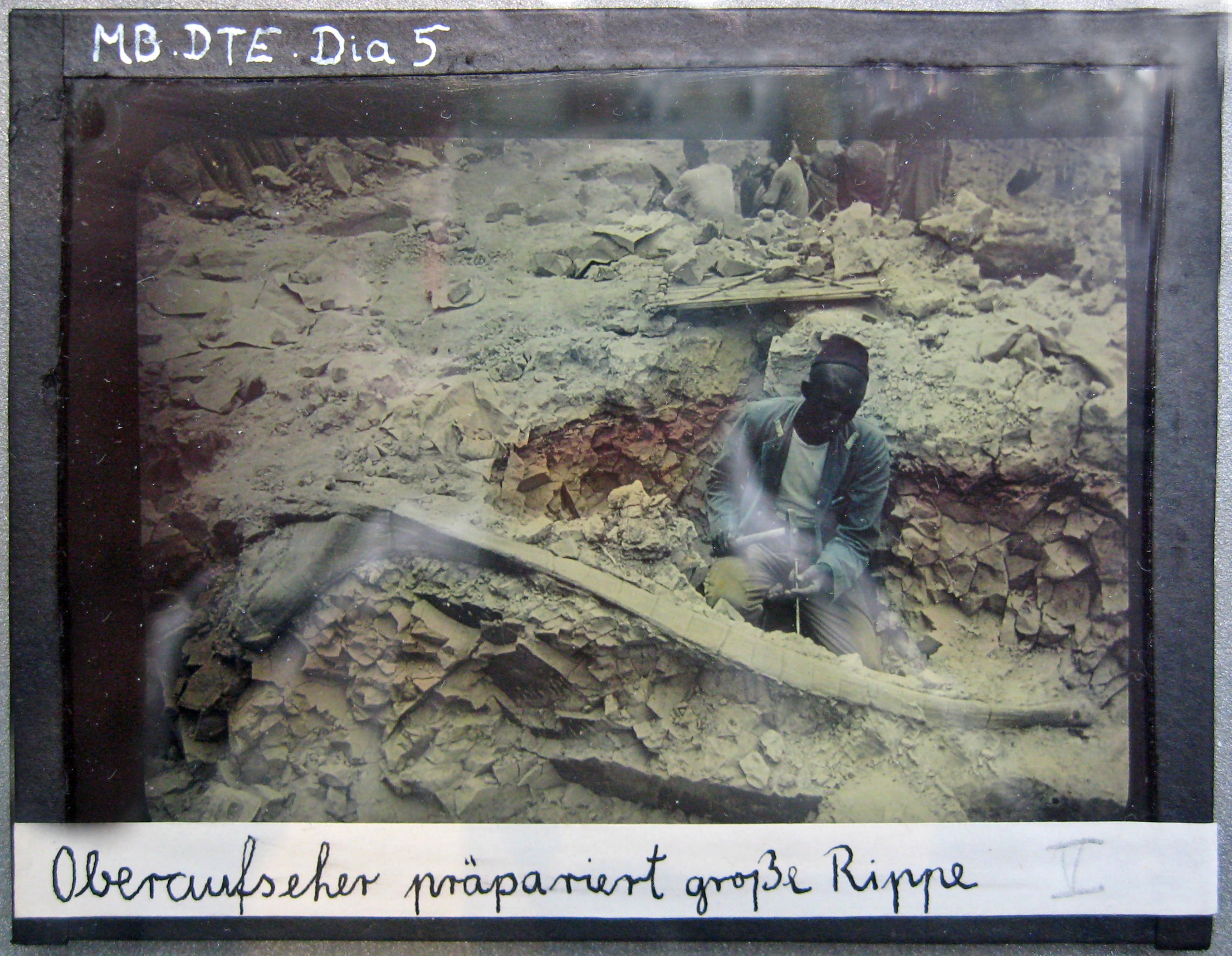|
Werner Janensch
Werner Ernst Martin Janensch (11 November 1878 – 20 October 1969) was a German paleontologist and geologist. Biography Janensch was born at Herzberg (Elster). In addition to Friedrich von Huene, Janensch was probably Germany's most important dinosaur specialist from the early and middle twentieth century. His most famous and significant contributions stemmed from the expedition undertaken to the Tendaguru Beds in what is now Tanzania. As leader of an expedition (together with Edwin Hennig) set up by the Museum für Naturkunde in Berlin, where he worked as a curator, Janensch helped uncover an enormous quantity of fossils of late Jurassic period dinosaurs, including several complete ''Brachiosaurus'' skeletons, then the largest animal ever known. During his long subsequent career (he worked in Berlin from 1914 to 1961), Janensch named several new dinosaur taxa including '' Dicraeosaurus'' (1914) and '' Elaphrosaurus'' (1920). Janensch's ''Brachiosaurus'' were later d ... [...More Info...] [...Related Items...] OR: [Wikipedia] [Google] [Baidu] |
Janensch
Janensch is a German surname. Notable people with the surname include: * Gerhard Janensch (1860–1933), German sculptor * Paul Janensch (born 1938), American journalist *Werner Janensch Werner Ernst Martin Janensch (11 November 1878 – 20 October 1969) was a German paleontologist and geologist. Biography Janensch was born at Herzberg (Elster). In addition to Friedrich von Huene, Janensch was probably Germany's most ... (1878–1969), German paleontologist and geologist {{surname German-language surnames ... [...More Info...] [...Related Items...] OR: [Wikipedia] [Google] [Baidu] |
Taxa
In biology, a taxon (back-formation from ''taxonomy''; : taxa) is a group of one or more populations of an organism or organisms seen by taxonomists to form a unit. Although neither is required, a taxon is usually known by a particular name and given a particular ranking, especially if and when it is accepted or becomes established. It is very common, however, for taxonomists to remain at odds over what belongs to a taxon and the criteria used for inclusion, especially in the context of rank-based (" Linnaean") nomenclature (much less so under phylogenetic nomenclature). If a taxon is given a formal scientific name, its use is then governed by one of the nomenclature codes specifying which scientific name is correct for a particular grouping. Initial attempts at classifying and ordering organisms (plants and animals) were presumably set forth in prehistoric times by hunter-gatherers, as suggested by the fairly sophisticated folk taxonomies. Much later, Aristotle, and later st ... [...More Info...] [...Related Items...] OR: [Wikipedia] [Google] [Baidu] |
German Paleontologists
German(s) may refer to: * Germany, the country of the Germans and German things **Germania (Roman era) * Germans, citizens of Germany, people of German ancestry, or native speakers of the German language ** For citizenship in Germany, see also German nationality law **Germanic peoples (Roman era) *German diaspora * German language * German cuisine, traditional foods of Germany People * German (given name) * German (surname) * Germán, a Spanish name Places * German (parish), Isle of Man * German, Albania, or Gërmej * German, Bulgaria * German, Iran * German, North Macedonia * German, New York, U.S. * Agios Germanos, Greece Other uses * German (mythology), a South Slavic mythological being * Germans (band), a Canadian rock band * "German" (song), a 2019 song by No Money Enterprise * ''The German'', a 2008 short film * "The Germans", an episode of ''Fawlty Towers'' * ''The German'', a nickname for Congolese rebel André Kisase Ngandu See also * Germanic (disambiguati ... [...More Info...] [...Related Items...] OR: [Wikipedia] [Google] [Baidu] |
1969 Deaths
1969 (Roman numerals, MCMLXIX) was a common year starting on Wednesday of the Gregorian calendar, the 1969th year of the Common Era (CE) and ''Anno Domini'' (AD) designations, the 969th year of the 2nd millennium, the 69th year of the 20th century, and the 10th and last year of the 1960s decade. Events January * January 4 – The Government of Spain hands over Ifni to Morocco. * January 5 – Ariana Afghan Airlines Flight 701 crashes into a house on its approach to London's Gatwick Airport, killing 50 of the 62 people on board and two of the home's occupants. * January 14 – USS Enterprise fire, An explosion aboard the aircraft carrier USS Enterprise (CVN-65), USS ''Enterprise'' near Hawaii kills 28 and injures 314. * January 16 – First successful docking of two crewed spacecraft in orbit and the first transfer of crew from one space vehicle to another (by a space walk) between Soviet craft Soyuz 5 and Soyuz 4. * January 18 – Failure of Soyuz 5's service module to separ ... [...More Info...] [...Related Items...] OR: [Wikipedia] [Google] [Baidu] |
1878 Births
Events January * January 5 – Russo-Turkish War: Battle of Shipka Pass IV – Russian and Bulgarian forces defeat the Ottoman Empire. * January 9 – Umberto I becomes King of Italy. * January 17 – Russo-Turkish War: Battle of Philippopolis – Russian troops defeat the Ottoman Empire. * January 23 – Benjamin Disraeli orders the British fleet to the Dardanelles. * January 24 – Russian revolutionary Vera Zasulich shoots at Fyodor Trepov, Governor of Saint Petersburg. * January 28 – In the United States: ** The world's First Telephone Exchange begins commercial operation in New Haven, Connecticut. ** '' The Yale News'' becomes the first daily college newspaper in the U.S. * January 31 – Turkey agrees to an armistice at Adrianople. February * February 2 – Greece declares war on the Ottoman Empire. * February 7 – Pope Pius IX dies, after a 31½ year pontificate (the longest definitely confirmed). * February 8 & ... [...More Info...] [...Related Items...] OR: [Wikipedia] [Google] [Baidu] |
Waldfriedhof Dahlem
The Waldfriedhof Dahlem (Dahlem (Berlin), Dahlem forest cemetery) is a cemetery in Berlin, in the district of Steglitz-Zehlendorf on the edge of the Grunewald (forest), Grunewald forest at Hüttenweg 47. Densely planted with conifers and designed between 1931 and 1933 after the plans of Albert Brodersen, it is one of Berlin's more recent cemeteries. Its graves include those of writers such as Gottfried Benn, composers such as Wolfgang Werner Eisbrenner and entertainers like Harald Juhnke, and put it among the so-called "Prominentenfriedhöfe" or celebrity cemeteries. Graves of notable people * Karl Anton (1898–1979), film director and film producer * Michael Ballhaus (1935–2017), cinematographer * Antoinette Becker (1920–1998), writer * Carl Heinrich Becker (1876–1933), orientalist and politician * Gottfried Benn (1886–1956), poet * Heinz Berggruen (1914–2007), art collector * Frank Michael Beyer (1928–2008), composer * Hans-Otto Borgmann (1901–1977), film co ... [...More Info...] [...Related Items...] OR: [Wikipedia] [Google] [Baidu] |
Ernst Lebrecht Henneberg
Ernst Lebrecht Henneberg (27 September 1850 – 29 April 1933) was a German professor of mechanics and mathematics. Life Ernst Lebrecht Henneberg was born in Wolfenbüttel in 1850 to Heinrich Henneberg and Sophie Rimpau. From 1870 until 1876 he studied mathematics in Zürich, Heidelberg, and Berlin, receiving his doctorate in 1875 from Hermann Schwarz while in Zürich. After living in Zürich from 1876 until 1878, he became an associate professor for descriptive and synthetic geometry and graphic statics at TU Darmstat. Not soon after in 1879, he became a professor of mechanics at the university. From 1887 to 1890 Henneberg was the dean of the Electrical Engineering school at TU Darmstat. In 1888, Henneburg was elected as a member of the Leopoldina. By 1890, he was one of the founders of the German Association of Mathematicians. From 1890 to 1891 Henneberg had become the dean of the Mathematics and Sciences school, while also acting as the rector from 1891 to 1893. In 190 ... [...More Info...] [...Related Items...] OR: [Wikipedia] [Google] [Baidu] |
Humboldt-Universität Zu Berlin
The Humboldt University of Berlin (, abbreviated HU Berlin) is a public research university in the central borough of Mitte in Berlin, Germany. The university was established by Frederick William III on the initiative of Wilhelm von Humboldt, Johann Gottlieb Fichte and Friedrich Daniel Ernst Schleiermacher as the University of Berlin () in 1809, and opened in 1810. From 1828 until its closure in 1945, it was named the (Royal) Friedrich Wilhelm University of Berlin (FWU Berlin; ). During the Cold War, the university found itself in East Berlin and was ''de facto'' split in two when the Free University of Berlin opened in West Berlin. The university received its current name in honour of Alexander and Wilhelm von Humboldt in 1949. The university is divided into nine faculties including its medical school shared with the Freie Universität Berlin. The university has a student enrollment of around 35,000 students, and offers degree programs in some 171 disciplines from undergrad ... [...More Info...] [...Related Items...] OR: [Wikipedia] [Google] [Baidu] |
Prussian Academy Of Sciences
The Royal Prussian Academy of Sciences () was an academy established in Berlin, Germany on 11 July 1700, four years after the Prussian Academy of Arts, or "Arts Academy," to which "Berlin Academy" may also refer. In the 18th century, when French was the language of science and culture, it was a French-language institution. Origins Prince-elector Frederick III of Brandenburg, Germany founded the Academy under the name of ''Kurfürstlich Brandenburgische Societät der Wissenschaften'' ("Electoral-Brandenburger Society of Sciences") upon the advice of Gottfried Wilhelm Leibniz, who was appointed president. Unlike other Academies, the Prussian Academy was not directly funded out of the state treasury. Frederick granted it the monopoly on producing and selling calendars in Brandenburg, a suggestion from Leibniz. As Frederick was crowned "King in Prussia" in 1701, creating the Kingdom of Prussia, the Academy was renamed ''Königlich Preußische Sozietät der Wissenschaften'' ("Royal ... [...More Info...] [...Related Items...] OR: [Wikipedia] [Google] [Baidu] |
Giraffatitan
''Giraffatitan'' (name meaning "titanic giraffe") is a genus of sauropod dinosaur that lived during the late Jurassic Period (geology), Period (Kimmeridgian–Tithonian stages) in what is now Lindi Region, Tanzania. Only one species is known, ''G. brancai'', named in honor of Germans, German paleontologist Wilhelm von Branca, who was a driving force behind the expedition that discovered it in the Tendaguru Formation. ''Giraffatitan brancai'' was originally described by German paleontologist Werner Janensch as a species of the North American sauropod ''Brachiosaurus'' from the Morrison Formation, as ''Brachiosaurus brancai''. Recent research shows that the differences between the type species of ''Brachiosaurus'' and the Tendaguru material are so large that the African material should be placed in a separate genus. ''Giraffatitan'' was for many decades known as the largest dinosaur but recent discoveries of several larger dinosaurs prove otherwise; giant titanosaurians app ... [...More Info...] [...Related Items...] OR: [Wikipedia] [Google] [Baidu] |
Elaphrosaurus
''Elaphrosaurus'' ( ) is a genus of ceratosaurian Theropoda, theropod dinosaur that lived approximately 154 to 150 million years ago during the Late Jurassic, Late Jurassic Period in what is now Tanzania in Africa. ''Elaphrosaurus'' was a medium-sized but lightly built member of the group that could grow up to long. Morphologically, this dinosaur is significant in two ways. Firstly, it has a relatively long body but is very shallow-chested for a theropod of its size. Secondly, it has very short hindlimbs in comparison with its body. Phylogenetic analyses indicate that this genus is likely a ceratosaur. Earlier suggestions that it is a late surviving coelophysoid have been examined but generally dismissed. ''Elaphrosaurus'' is currently believed to be a very close relative of ''Limusaurus'', an unusual beaked ceratosaurian which may have been either herbivorous or omnivorous. Discovery The type specimen of ''Elaphrosaurus bambergi'' HMN Gr.S. 38–44 was recovered in the Middl ... [...More Info...] [...Related Items...] OR: [Wikipedia] [Google] [Baidu] |





